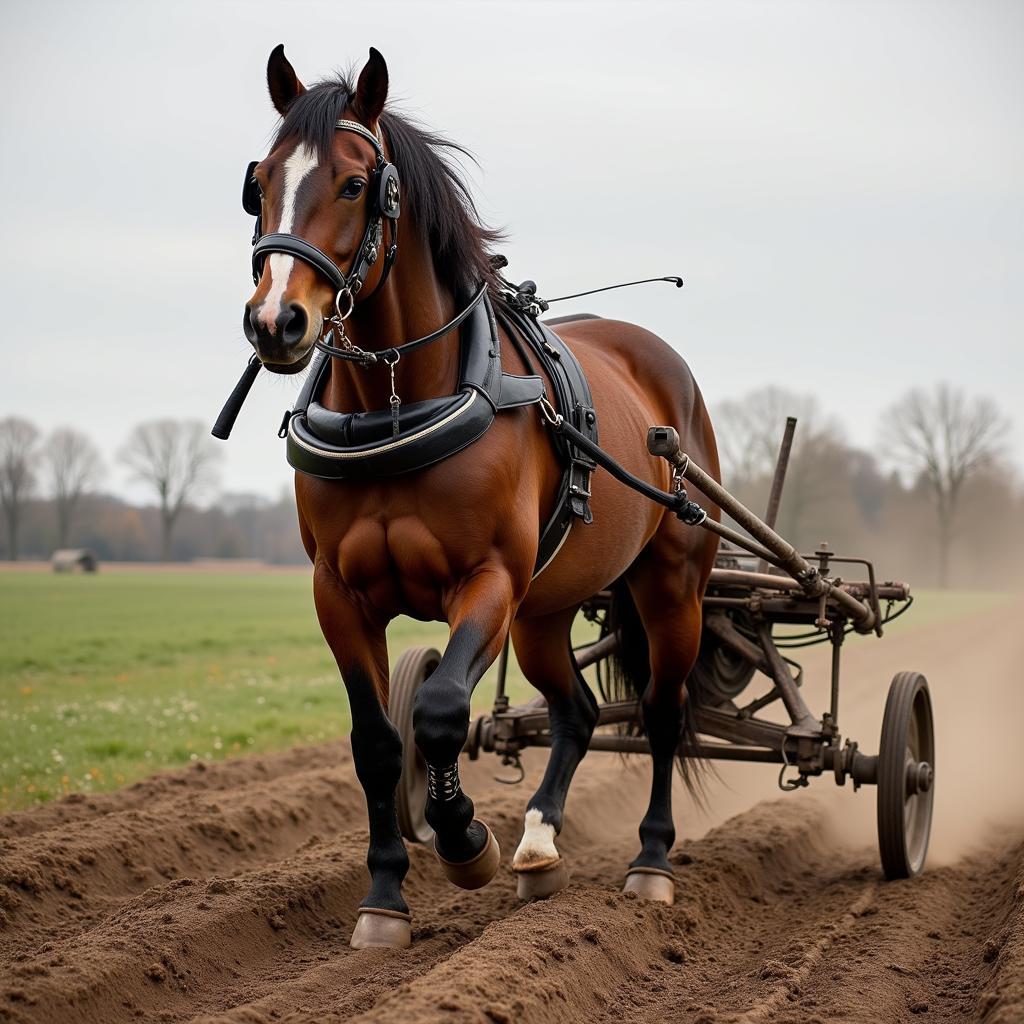Draft horses and regular riding horses, while both undeniably equine, possess distinct characteristics that set them apart. From their impressive size and gentle nature to their varied roles in work and leisure, understanding these differences is crucial for any horse enthusiast. Choosing the right horse for your needs hinges on recognizing these key distinctions. Let’s dive into the fascinating world of draft horses and regular riding horses.
Size and Build: A Striking Contrast
One of the most obvious differences between draft and riding horses lies in their physique. Draft horses are colossal, bred for strength and power. Their broad chests, thick legs, and feathered hooves are testaments to their working heritage. In contrast, riding horses, also known as light horses, are significantly smaller and more agile, built for speed and maneuverability. Thinking of purchasing a 2 horse living quarters horse trailer for sale? A draft horse’s size may require special considerations.
Height and Weight: Measuring the Difference
Draft horses can reach impressive heights, often exceeding 17 hands high and weighing over a ton. Riding horses, on the other hand, typically range from 14 to 16 hands high and weigh between 900 and 1,500 pounds. This substantial difference in size impacts everything from their gait to their dietary needs.
Temperament and Personality: Gentle Giants vs. Spirited Steeds
While generalizations are never absolute, draft horses are renowned for their calm and docile temperaments. Their gentle nature makes them ideal for working with families and beginner riders. Riding horses, in contrast, exhibit a wider range of temperaments, from the fiery Thoroughbred to the more laid-back Quarter Horse. Selecting a horse with a personality compatible with your experience level is essential.
 Draft Horse Pulling a Plow
Draft Horse Pulling a Plow
Historical Roles and Modern Uses: From Farm to Show Ring
Historically, draft horses were the backbone of agriculture, pulling plows, hauling logs, and transporting goods. Their strength and endurance were invaluable assets in pre-industrial societies. Today, while still used in some agricultural settings, draft horses are increasingly popular for recreational riding, driving, and showing. Considering a hard brush for horses? A draft horse’s thick coat requires special attention. Riding horses, bred for speed and agility, have long been prized for their athleticism in disciplines like racing, jumping, and dressage.
Choosing the Right Horse for You: Considering Your Needs
The ideal horse, draft or riding, depends entirely on your individual needs and goals. Are you seeking a steady companion for leisurely trail rides? A draft horse’s gentle nature might be perfect. Do you aspire to compete in high-energy equestrian sports? A riding horse’s athleticism is likely a better fit.
“Understanding the historical roles of these breeds often provides insights into their temperaments and physical attributes,” says renowned equine expert Dr. Amelia Cartwright. “This historical context is crucial when matching a horse to an owner’s specific needs.”
Comparing Draft and Riding Horses: A Quick Glance
| Feature | Draft Horse | Riding Horse |
|---|---|---|
| Size | Large, heavy | Smaller, lighter |
| Temperament | Calm, docile | Varies widely |
| Historical Use | Work, agriculture | Riding, sport |
| Modern Use | Recreation, driving, showing | Racing, jumping, dressage |
What are the most common draft horse breeds?
Some of the most common draft horse breeds include Clydesdales, Belgians, Percherons, and Shires. These breeds are renowned for their impressive size and gentle nature. Ever wondered about the differences between a clydesdale vs quarter horse? It’s a stark contrast.
Are draft horses good for beginners?
Draft horses’ calm temperament often makes them suitable for beginner riders, particularly under the guidance of an experienced instructor.
What are riding horses used for?
Riding horses are used for a wide range of disciplines, from racing and jumping to dressage and trail riding. They are also used for pleasure riding and equestrian therapy. They can even be seen as hallmark carousel horses.
Conclusion: Choosing Your Equine Partner
Ultimately, the choice between a draft horse and a regular riding horse is a personal one. By understanding the key differences in size, temperament, and historical roles, you can make an informed decision and find the perfect equine partner to share your passion for horses. Proper care, including appropriate horse feeder buckets, is essential for both types. Remember, choosing the right horse is the first step in building a lasting bond.
FAQ
- Are draft horses more expensive than riding horses?
- What are the health concerns specific to draft horses?
- Can draft horses be used for riding lessons?
- What is the average lifespan of a draft horse compared to a riding horse?
- Are there specific riding disciplines suitable for draft horses?
- What kind of tack is needed for a draft horse?
- Do draft horses require more food than riding horses?
For assistance, contact us at Phone Number: 0772127271, Email: [email protected] Or visit us at: QGM2+WX2, Vị Trung, Vị Thuỷ, Hậu Giang, Việt Nam. We have a 24/7 customer service team.